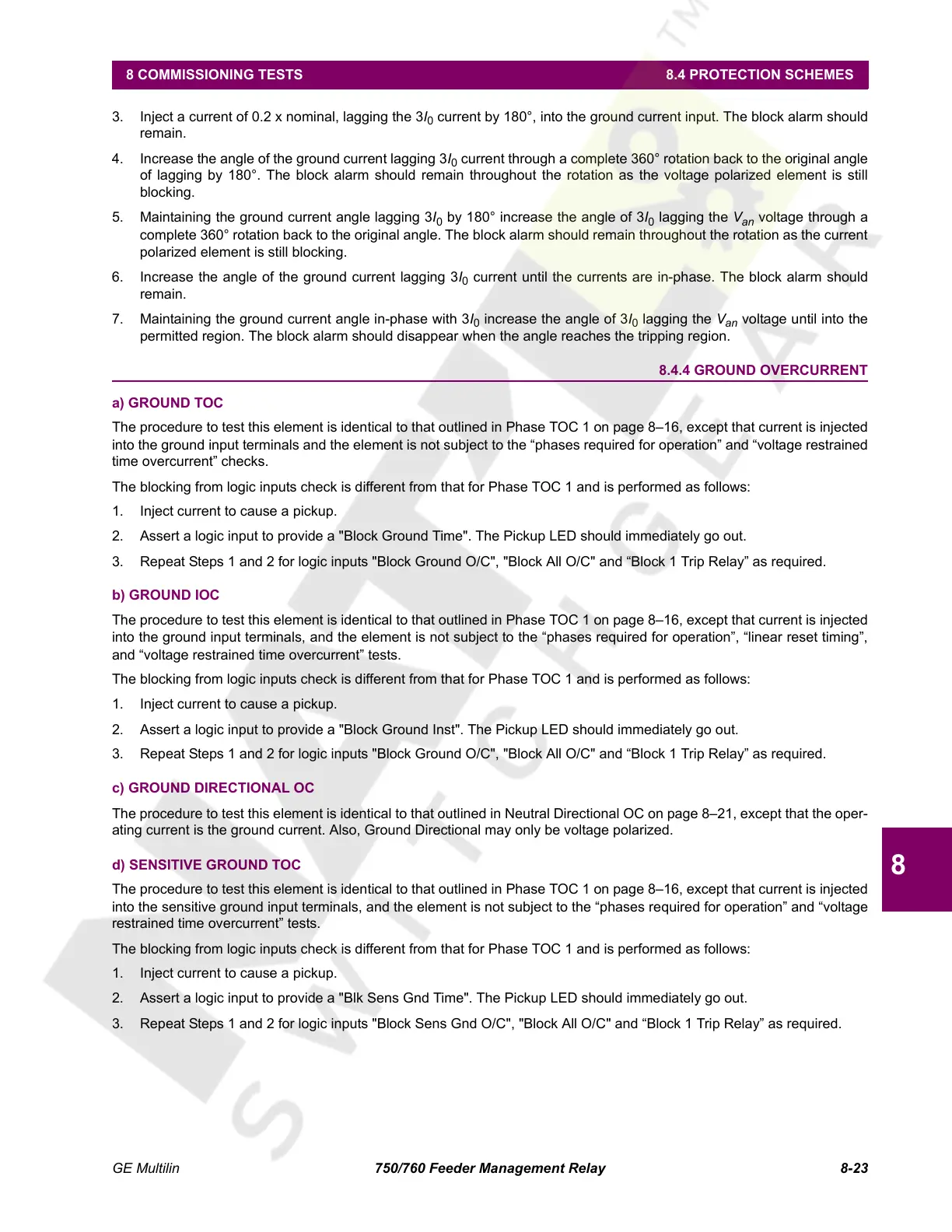GE Multilin 750/760 Feeder Management Relay 8-23
8 COMMISSIONING TESTS 8.4 PROTECTION SCHEMES
8
3. Inject a current of 0.2 x nominal, lagging the 3I
0
current by 180°, into the ground current input. The block alarm should
remain.
4. Increase the angle of the ground current lagging 3I
0
current through a complete 360° rotation back to the original angle
of lagging by 180°. The block alarm should remain throughout the rotation as the voltage polarized element is still
blocking.
5. Maintaining the ground current angle lagging 3I
0
by 180° increase the angle of 3I
0
lagging the V
an
voltage through a
complete 360° rotation back to the original angle. The block alarm should remain throughout the rotation as the current
polarized element is still blocking.
6. Increase the angle of the ground current lagging 3I
0
current until the currents are in-phase. The block alarm should
remain.
7. Maintaining the ground current angle in-phase with 3I
0
increase the angle of 3I
0
lagging the V
an
voltage until into the
permitted region. The block alarm should disappear when the angle reaches the tripping region.
8.4.4 GROUND OVERCURRENT
a) GROUND TOC
The procedure to test this element is identical to that outlined in Phase TOC 1 on page 8–16, except that current is injected
into the ground input terminals and the element is not subject to the “phases required for operation” and “voltage restrained
time overcurrent” checks.
The blocking from logic inputs check is different from that for Phase TOC 1 and is performed as follows:
1. Inject current to cause a pickup.
2. Assert a logic input to provide a "Block Ground Time". The Pickup LED should immediately go out.
3. Repeat Steps 1 and 2 for logic inputs "Block Ground O/C", "Block All O/C" and “Block 1 Trip Relay” as required.
b) GROUND IOC
The procedure to test this element is identical to that outlined in Phase TOC 1 on page 8–16, except that current is injected
into the ground input terminals, and the element is not subject to the “phases required for operation”, “linear reset timing”,
and “voltage restrained time overcurrent” tests.
The blocking from logic inputs check is different from that for Phase TOC 1 and is performed as follows:
1. Inject current to cause a pickup.
2. Assert a logic input to provide a "Block Ground Inst". The Pickup LED should immediately go out.
3. Repeat Steps 1 and 2 for logic inputs "Block Ground O/C", "Block All O/C" and “Block 1 Trip Relay” as required.
c) GROUND DIRECTIONAL OC
The procedure to test this element is identical to that outlined in Neutral Directional OC on page 8–21, except that the oper-
ating current is the ground current. Also, Ground Directional may only be voltage polarized.
d) SENSITIVE GROUND TOC
The procedure to test this element is identical to that outlined in Phase TOC 1 on page 8–16, except that current is injected
into the sensitive ground input terminals, and the element is not subject to the “phases required for operation” and “voltage
restrained time overcurrent” tests.
The blocking from logic inputs check is different from that for Phase TOC 1 and is performed as follows:
1. Inject current to cause a pickup.
2. Assert a logic input to provide a "Blk Sens Gnd Time". The Pickup LED should immediately go out.
3. Repeat Steps 1 and 2 for logic inputs "Block Sens Gnd O/C", "Block All O/C" and “Block 1 Trip Relay” as required.
Courtesy of NationalSwitchgear.com

